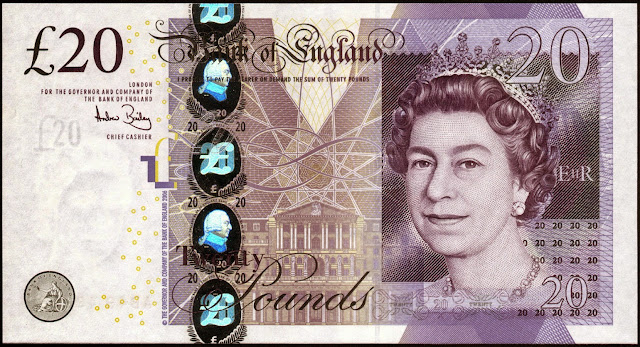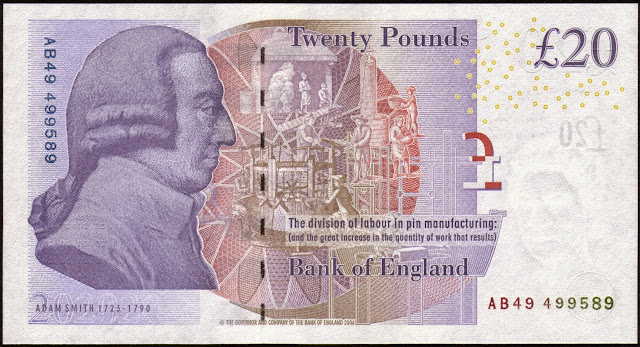British Banknotes 20 Pound Sterling note 2007 Adam Smith
Bank of England
Obverse: Portrait of Her Majesty Queen Elizabeth II at right. On patterned background is a building of Bank of England. In lower left corner is a Bank seal with sitting Britannia (as logo of Bank of England). Denominations in numerals are in top corners. In center in words. Many denominations in numerals are in lower right corner.
Reverse: Bust of Adam Smith in profile (1723-1790) is one of the fathers of modern economics. The engraving on banknote is made after the "paste medallion" portrait of Adam Smith created by Scottish gem engraver and modeller James Tassie in 1787. It is entitled "Adam Smith in his 64th year, 1787. Tassie F.". White enamel on a background of tinted glass.; Plate of Pin Making in The Encyclopedie, 1762 "The division of labour in pin manufacturing". In one of his great works, An Inquiry into the Nature and Causes of the Wealth of Nations, Smith famously used the example of workers in a pin factory to describe the benefits created by the division of labour, and, as explained on the note, 'the great increase in the quantity of work that results'.
Date of Issue: 13 March 2007.
Signature: Andrew Bailey, Chief Cashier of the Bank of England.
Printer: Bank of England Printing Works, Debden.
Original Size: 150 x 80 mm
Texts: Bank of England; I Promise to Pay the Bearer on Demand the Sum of Twenty Pounds; London, for the Governor and Company of the Bank of England. "The division of labour in pin manufacturing: (and the great increase in the quantity of work that results)".
Watermark - hold the £20 note up to the light and you will see an image of the Queen's portrait together with a bright £20.
Metallic thread - there is a metallic thread embedded in every banknote. This appears as silver dashes on the back of the £20 note. If you hold the note up to the light the metallic thread appears as a continuous dark line.
See-through register - hold the £20 note up to the light and you will see coloured irregular shapes printed on the front and back that combine to form the £ symbol.
Holographic strip - the strip on the £20 note has a number of foil patches along its length which contain alternating holographic images. The positioning of the patches varies along the strip. When the note is tilted, one hologram shows a multi-coloured image of Adam Smith, the other changes between a multi-coloured £ symbol and the number 20. The number 20 is also embossed on the strip and is positioned in the same place on every note - just to the right of the signature of the Chief Cashier.
Loading...
Great Britain banknotes - Great Britain paper money
Series F
In preparation for the "E Series" of notes, issued by the Bank of England, photographs of The Queen were especially commissioned by the Bank. The photographs were taken by Don Ford in 1985-1986, one of the Bank’s technical photographers, under the direction of Roger Withington. Mr. Withington designed the notes of the "E Series" and prepared the engraving of the Queen, which appeared on this series of notes, from one of the photographs taken by Mr. Ford. The portrait shows Queen Elizabeth wearing Queen Mary’s "Girls of Great Britain and Ireland" Tiara, Queen Alexandra’s cluster earrings and, although difficult to identify, Queen Victoria’s Golden Jubilee necklace.
5 Pounds 10 Pounds 20 Pounds 50 Pounds
Adam Smith
Adam Smith (16 June 1723 NS (5 June 1723 OS) – 17 July 1790) was a Scottish moral philosopher, pioneer of political economy, and key Scottish Enlightenment figure.
Smith is best known for two classic works: The Theory of Moral Sentiments (1759), and An Inquiry into the Nature and Causes of the Wealth of Nations (1776). The latter, usually abbreviated as The Wealth of Nations, is considered his magnum opus and the first modern work of economics. Smith is cited as the "father of modern economics" and is still among the most influential thinkers in the field of economics today.
Smith studied social philosophy at the University of Glasgow and at Balliol College, Oxford, where he was one of the first students to benefit from scholarships set up by fellow Scot, John Snell. After graduating, he delivered a successful series of public lectures at Edinburgh, leading him to collaborate with David Hume during the Scottish Enlightenment. Smith obtained a professorship at Glasgow teaching moral philosophy, and during this time he wrote and published The Theory of Moral Sentiments. In his later life, he took a tutoring position that allowed him to travel throughout Europe, where he met other intellectual leaders of his day.
Smith laid the foundations of classical free market economic theory. The Wealth of Nations was a precursor to the modern academic discipline of economics. In this and other works, he expounded upon how rational self-interest and competition can lead to economic prosperity. Smith was controversial in his own day and his general approach and writing style were often satirised by Tory writers in the moralising tradition of William Hogarth and Jonathan Swift. In 2005, The Wealth of Nations was named among the 100 Best Scottish Books of all time. It is said former UK Prime Minister Margaret Thatcher carried a copy of the book in her handbag.
An Inquiry into the Nature and Causes of the Wealth of Nations
An Inquiry into the Nature and Causes of the Wealth of Nations, generally referred to by its shortened title The Wealth of Nations, is the magnum opus of the Scottish economist and moral philosopher Adam Smith. First published in 1776, the book offers one of the world's first collected descriptions of what builds nations' wealth and is today a fundamental work in classical economics. By reflecting upon the economics at the beginning of the Industrial Revolution, the book touches upon such broad topics as the division of labor, productivity, and free markets.
The Wealth of Nations was published 9 March 1776, during the Scottish Enlightenment and the Scottish Agricultural Revolution. It influenced a number of authors and economists, as well as governments and organizations. For example, Alexander Hamilton was influenced in part by The Wealth of Nations to write his Report on Manufactures, in which he argued against many of Smith's policies. Interestingly, Hamilton based much of this report on the ideas of Jean-Baptiste Colbert, and it was, in part, Colbert's ideas that Smith responded to with The Wealth of Nations.
Many other authors were influenced by the book and used it as a starting point in their own work, including Jean-Baptiste Say, David Ricardo, Thomas Malthus and, later, Ludwig von Mises. The Russian national poet Aleksandr Pushkin refers to The Wealth of Nations in his 1833 verse-novel Eugene Onegin.
The Wealth of Nations was the product of seventeen years of notes, and observation of conversation among economists of the time concerning economic and societal conditions during the beginning of the Industrial Revolution, and took Smith ten years to produce. The result, An Inquiry to the Wealth of Nations, was a treatise which sought to offer a practical application for reformed economic theory to replace the mercantilist and physiocratic economic theories that were becoming less relevant in the time of industrial progress and innovation. It provided the foundation for new economists, politicians, mathematicians, biologists, and thinkers of all fields to build upon. Irrespective of historical influence, The Wealth of Nations represented a clear shift in the field of economics, comparable to Sir Isaac Newton's Principia Mathematica for physics, Antoine Lavoisier's Traité Élémentaire de Chimie for chemistry, or Charles Darwin's On the Origin of Species for biology.

